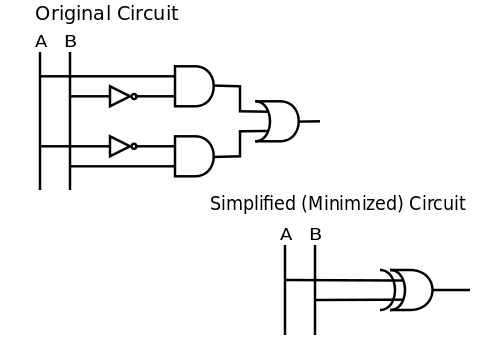- Circuit minimization
-
In Boolean algebra, circuit minimization is the problem of obtaining the smallest logic circuit (Boolean formula) that represents a given Boolean function or truth table. The general circuit minimization problem is believed to be intractable,[1] but there are effective heuristics such as Karnaugh maps and the Quine–McCluskey algorithm that facilitate the process.
Contents
Purpose
The problem with having a complicated circuit (i.e. one with many elements, such as logical gates) is that each element takes up physical space in its implementation and costs time and money to produce in itself.
Example
While there are many ways to minimize a circuit, this is an example that minimizes (or simplifies) a boolean function. Note that the boolean function carried out by the circuit is directly related to the algebraic expression from which the function is implemented.[2] Consider the circuit used to represent
 . It is evident that two negations, two conjunctions, and a disjunction are used in this statement. This means that to build the circuit one would need two inverters, two AND gates, and an OR gate.
. It is evident that two negations, two conjunctions, and a disjunction are used in this statement. This means that to build the circuit one would need two inverters, two AND gates, and an OR gate.We can simplify (minimize) the circuit by applying logical identities or using intuition. Since the example states that A is true when B is false or the other way around, we can conclude that this simply means
 . In terms of logical gates, inequality simply means an XOR gate (exclusive or). Therefore,
. In terms of logical gates, inequality simply means an XOR gate (exclusive or). Therefore,  . Then the two circuits shown below are equivalent:
. Then the two circuits shown below are equivalent:You can additionally check the correctness of the result using a truth table.
See also
- Binary decision diagram
- Espresso heuristic logic minimizer
- Karnaugh map
- Prime implicant
- Circuit complexity
- Function composition
- Function decomposition
References
- ^ Kabanets, Valentine; Cai, Jin-Yi (2000), "Circuit minimization problem", Proc. 32nd Symposium on Theory of Computing, Portland, Oregon, USA, pp. 73–79, doi:10.1145/335305.335314, ECCC TR99-045.
- ^ M. Mano, C. Kime. "Logic and Computer Design Fundamentals" (Fourth Edition). Pg 54
Further reading
- De Micheli, Giovanni. Synthesis and Optimization of Digital Circuits. McGraw-Hill, 1994, Part III, Logic-Level Syntesis and Optimization
- Zvi Kohavi, Niraj K. Jha. Switching and Finite Automata Theory. 3rd ed. Cambridge University Press. 2009. ISBN 9780521857482, chapters 4–6
Categories:- Boolean algebra
- Circuit complexity
- Logic in computer science
- Electronics optimization
- Computer science stubs
Wikimedia Foundation. 2010.

